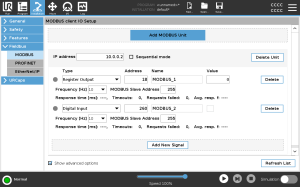MODBUS
| Refresh |
Push this button to refresh all MODBUS connections. Refreshing disconnects all modbus units, and connects them back again. All statistics are cleared.
|
| Add unit |
Push this button to add a new MODBUS unit.
|
| Delete unit |
Push this button to delete the MODBUS unit and all signals on that unit.
|
| Set unit IP |
Here the IP address of the MODBUS unit is shown. Press the button to change it.
|
| Add signal |
Push this button to add a signal to the corresponding MODBUS unit.
|
| Delete signal |
Push this button to delete a MODBUS signal from the corresponding MODBUS unit.
|
| Set signal address |
This field shows the address on the remote MODBUS server. Use the on-screen keypad to choose a different address. Valid addresses depends on the manufacturer and configuration of the remote MODBUS unit.
|
| Set signal name |
Using the on-screen keyboard, the user can give the signal a name. This name is used when the signal is used in programs.
|
| Signal value |
Here, the current value of the signal is shown. For register signals, the value is expressed as an unsigned integer. For output signals, the desired signal value can be set using the button. Again, for a register output, the value to write to the unit must be supplied as an unsigned integer.
|
| Signal connectivity status |
This icon shows whether the signal can be properly read/written (green), or if the unit responds unexpected or is not reachable (gray). If a MODBUS exception response is received, the response code is displayed. The MODBUS-TCP Exception responses are:
|
| Show Advanced Options |
This check box shows/hides the advanced options for each signal.
|
| Advanced Options |
All counters count up to 65535, and then wrap back to 0.
|
MODBUS Client I/O
| Description |
The MODBUS Client I/O signals as they are set up in the installation. Using the drop-down menus at the top of the screen, you can change the displayed content based on signal type and MODBUS unit if more than one is configured. Each signal in the lists contains its connections status, value, name, and signal address. The output signals can be toggled if the connection status and the choice for I/O tab control allows it.
|

